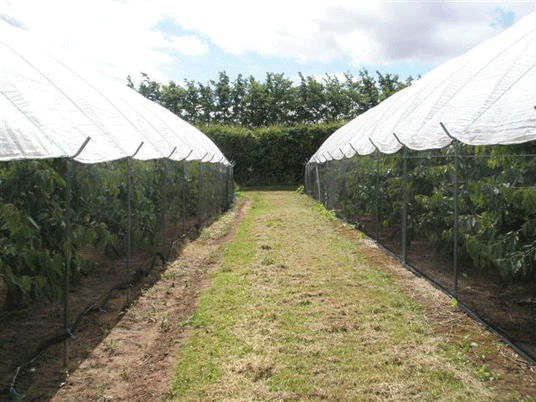For many years, the press has been full of stories about fruit farmers ripping up their orchards as they lose out to low price competition from overseas.
One company that has gainsaid this trend in an astonishingly successful manner is Lower Hope Farms – a diverse business consisting of many farming enterprises on the beautiful Malvern Hills in North Herefordshire. While the estate covers 1800 acres, the home farm is at Lower Hope, Ullingswick, home to the owners, Mr & Mrs Clive Richards. The livestock enterprises include a successful herd of Pedigree Hereford Cattle, a Pedigree Suffolk flock as well as a commercial ewe flock, while the Estate also farms a large area of arable land, wheat, rape, canary seed in rotation with potatoes.
According to Clive Richards, “Fruit production has been increasing year on year. The fruit farm produces cherries, raspberries and apples, for supermarket and wholesale consumption. Then, about 11 years ago, I decided to go into cherry growing. I planted 11 acres of Colt rootstock as I was reliably informed that this was the best rootstock but they haven’t come up to expectations – we were told to expect around 6 tonnes per acre but only got around half that. After year four, a new rootstock – Gizella 5, quickly followed by Gizella 6 – was trialled and this has come up to expectation to the extent that, of our current 100 acres of cherries, 90 are Gizella 5.”
Growing cherries on the Malvern Hills is very different to growing them further south, for example in Kent. The trees are planted much further north and at higher altitude and so cropping tends to be later. Clive explains, “This is an advantage for us as our cherries are ready from July onwards, which is after those from Kent, the USA and Turkey are coming to an end. Indeed we are now investigating other varieties and looking to plant them on a north-facing aspect in order to produce even later crops, so extending our season further into September. This enables us to get better prices for our crop.”
The cherry trees at Lower Hope are kept to a height of 6-8 feet with around 800 trees per acre and, during the flowering and cropping season are kept under plastic covers, with every tree being individually irrigated. This protects the flowers from the frost and the crop from damage.
Back to Clive, “Over the 11 years that we have been growing cherries, we have travelled all over the world looking at how other people do things and, as a result, we believe that we are probably at the forefront of cherry growing technology. Our trees produce the large, dark, luscious, sweet cherries that are preferred by Marks and Spencer and we are their key supplier from July to September. All our fruit is carefully picked and then put through a hydrocooler that washes and grades every single cherry. Those of 28mm and above go to Marks & Spencer while those from 28-20mm go to other supermarkets and the wholesale market. Although the hydrocooler was an expensive piece of equipment, it does enable us to maximise the price we can get for every cherry. To maintain our quality and the quantity that we produce, we are carrying out a continual programme of replacing some of our older trees – particularly the Colt variety – planting up more acres, trialling later varieties and the more north facing aspects. This year we won the award as Fruit Grower of the Year which shows how successful we are becoming!”
For further information please telephone 01432 820218 or visit www.lowerhopefarms.co.uk


